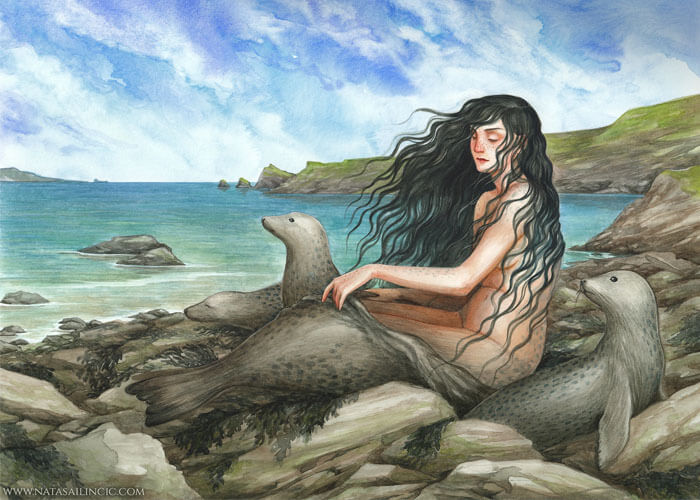Have you ever wondered what these enchanting creatures are that dance between folklore and the waves? Let me introduce you to the fascinating world of selkies.
What is a Selkie? Imagine beings that can transform from seals into humans. This has captured the imagination of coastal communities throughout the centuries. These magical creatures are rooted in Celtic mythology and Nordic legends, and tell stories of love, longing, and the endless sea.
Join me as we explore the mystery of the selkie. Prepare to be enchanted with the folklore of these shape-shifting wonders and the oceans that they call home.
What is a Selkie? Detailed Guide
Definition and Origin
The Celtic mythology of Selkies describes enchanting creatures that live in both the human and the marine world. The word “selkie”, which means seal in Scottish and Irish Gaelic, has its origins in Celtic folklore.
Legends say that seals can shed their skin to reveal a human-like form underneath, symbolizing the magical connection between ocean and land. These mythical creatures are woven into the rich tapestry maritime folklore and add an air of mystery to coastal towns.
Appearance and Characteristics
Selkies are renowned for their dual nature, as both sleek seals and attractive humans. In seal form, they have a glossy fur and soulful eye and effortlessly navigate the ocean depths. When they don their human form, selkies have an otherworldly appeal, often described by others as ethereal or bewitching.
Legends portray them as melancholic characters, longing for the vastness and complexity of the sea. Their ability to seamlessly switch between these two forms lends an aura of fascination and magic, leaving a permanent mark on the tales spun in coastal communities.

Selkie Folklore
Cultural Roots (Mentioning Irish or Scottish Folklore).
The rich tapestry of Irish, Scottish, and other cultural traditions is the source of Selkie folklore. In these Celtic realms, tales of selkies were spun through generations.
The word “selkie,” which means seal in Scottish Gaelic, is derived from the Scottish and Irish Gaelic “selch.” These mythical creatures embody the mystical link between the sea and the human world. They capture the imaginations of people living along the rugged coasts.
Stories and Myths about Selkies
Selkie tales are a captivating blend of magic, love, and the elemental powers of the sea. Legends are often based on the selkies’ ability to switch between human and seal forms.
One of the most common themes is the discovery of the sealskin of a selkie, a magical garment that grants the power of change. Folklore is rife with tales of love and separation between selkies, as well as the consequences of tampering with a sealskin.
These stories, handed down through the generations, continue to captivate audiences. They paint a vivid picture in which the sea and human emotion are intertwined into tales of enchantment.
The Selkie Transformation
The selkie mythology revolves around the mythical beings’ ability to seamlessly switch between human and seal forms. Imagine a serene sea where a selkie gracefully changes from a sleek seal to a captivating human. This is the magical connection between ocean and land.
This metamorphosis is often triggered by the wearing or shedding of a sealskin. It adds a sense of mystery and wonder in Selkie stories.
Shifting between seal and human form
Selkies are known for their dual nature, navigating the ocean depths as seals while gracing shores in human form.
The transformation is often portrayed as a mystical, ethereal dance where the boundaries of the aquatic and terrestrial realms are blurred. The selkies’ ability to transform between the two forms, whether they are gliding over the waves or walking on the sandy shore, captures the imagination and leaves an indelible impression on coastal folklore.

Seal Skins in Selkie Tales: Their Importance
In many selkie tales, the possession of sealskin has a profound significance. The sealskin can be used to transform between seal and human form.
When a sealskin is shed, a selkie enters the human realm, vulnerable but bewitching. If a human hides and obtains the sealskin of a selkie, it will remain in its human form. This illustrates the delicate balance of the enchanting allure and earthly ties that humans share.
Sealskin is a symbol of autonomy, destiny, and the dance between the mystical, and the mundane, in selkie mythology.
Selkies Symbolism
The rich tapestry in folklore is woven with symbols that transcend myth. Themes interwoven in their tales offer insights into the human experience. They provide insights into love and freedom, as well as the enduring relationship between humanity and nature. These mythical beings are metaphors that invite us to explore identity, transformation, and the eternal dance of the elements.
Themes in Selkie Stories
The themes of the stories of selkies are universal and resonate with cultures around the world. Love and loss are at the forefront as selkies navigate their relationships, torn by the call of the ocean and earthly ties.
The transformative power explored by the sealskin explores autonomy and its consequences. Themes of secrecy and longing, as well as the inevitable clash between the mundane and the mystical, weave a narrative tapestry that captures the hearts and minds of both.
Interpretations and Cultural Significance
The stories of the Selkies are interpreted differently, reflecting the cultural differences in the regions they originate from. In some stories, they represent the untamed forces of nature. In others, they symbolize the delicate balance between the familiar and the mysterious.
The cultural significance of the selkies goes beyond entertainment. They offer a lens for communities to grapple with the relationship they have to the sea, their identity, and the transient nature of life. Selkies are metaphors for our human condition. They invite us to explore our own emotions and connect us with the enduring folklore that binds us to the mysteries in the natural world.
Selkies in Popular Culture
The mystical appeal of the selkie has gracefully migrated to popular culture from ancient folklore, leaving a lasting mark on literature and films alike.
These captivating beings have made their way into the hearts and minds of audiences, enriching narrative landscapes with their tales about transformation and enchantment.
References to Literature and Movies
Selkies are the inspiration for countless works of fiction and film. Their ethereal presence adds a touch of magical to storytelling.
In literature, selkie themes have been woven into novels and stories to explore the nuances of identity, love, and the intersection between the natural and supernatural.
The silver screen has also been enchanted by selkies. Movies have showcased their captivating stories and brought these mythical creatures to life for audiences all over the world.

Modern Adaptations, Influences, and Influences
Selkies continue to captivate modern minds, and creative minds are constantly adapting and reimagining the stories. Novels in contemporary literature explore the complexity of selkie legends, offering new perspectives on age-old stories.
In cinema, selkies continue making a splash. They capture audiences in both traditional as well as innovative ways. The selkie’s influence on popular culture is a testament to their timeless appeal.
The fascination with these magical beings ensures that they remain relevant and loved across generations.
Influences in the Real World
While selkies are primarily associated with folklore, they have real-world impacts, especially in the contexts of marine ecology and traditional practices.
The selkie tales are infused with subtle references to the natural environment, reflecting the relationship between coastal communities as well as the marine environment.
Connection to Marine Ecology
As mythical beings that bridge the sea and the land, selkies inspire coastal residents to connect with marine ecology. Seals in their original state are a great way to show how these creatures are intertwined with the oceans.
The selkie mythology, rooted along the coast, reflects the ebbs and flows of marine ecosystems. It emphasizes the delicate balance that exists between the underwater world and the human realm.
Impact on local traditions and beliefs
Selkies are a part of the culture and traditions of coastal communities. These mythical creatures, with their stories of love and longing become intertwined in the narratives of those who live by the sea.
Local customs and superstitions are often influenced by selkie lore. They shape the way communities interact with nature and perceive it. The influence of selkies goes beyond mythology, affecting the customs and beliefs in coastal societies.
FAQs:
Are selkies good or bad?
Selkies tend to be portrayed as neither good nor evil. Their nature is often shaped and influenced by the stories that they are a part of.
In some tales, selkies can be portrayed as benevolent, enchanting creatures, while in other tales their interactions with humans can lead to both happiness and heartache.
The selkies are described differently in different folklore, highlighting their nuanced nature.
What is the difference between sirens and selkies?
Both sirens and selkies are mythical sea creatures. However, they differ in their characteristics. The Greek mythology of sirens depicts them as seductive creatures, with captivating voices that lure sailors to their deaths.
Selkies are seals that can transform into humans. They are rooted in Celtic mythology. Selkie stories are often centered around themes such as love, transformation, and the delicate balance of the sea and the human world.
What is a Selkie in Scotland?
In Scotland, the selkie is an imaginary being that represents the magical connection between the sea and the human world. A selkie’s origins are Celtic folklore. It is often portrayed as a seal that can shed its skin and reveal a human body.
These magical beings are at the heart of stories of love, loss and the dance between the natural world and human experiences on the Scottish coasts.
Can a human be a selkie or vice versa?
In traditional Selkie mythology, the idea of a person becoming a seal is not common. In traditional tales, selkies were usually seals who could transform into humans after shedding their skin.
Individual adaptations or creative interpretations can present variations in which a human becomes entwined into selkie lore.
Why are kelpies so feared by Scottish folklore and culture?
Kelpies are feared by Scots folklore because of their malign nature and association with the water. These mythical creatures have been depicted as water spirits who can change into horses.
Legend has it that the kelpies will lure unwary travelers, particularly children, to mount them, before dragging them to their death in the water. The fear of kelpies has been ingrained in people for centuries.
The dangers of bodies of water are a common theme in the stories shared by Scottish communities.
Conclusion:
A selkie, in conclusion, is a mythical creature deeply rooted in Celtic culture, especially in the traditions of Scotland, and Ireland. A selkie is a mythical creature that can seamlessly transform between the forms of an elegant seal and a captivating human. The essence of the selkie is the mystical link between the sea and the human world.
The question “What is selkie?” unlocks a whole world of stories that explore themes such as love, loss, and a delicate dance between nature and the supernatural. Selkies, whether they are seals navigating the depths of the ocean, or humans gracing shores, embody a magic that transcends time and captures the imaginations of coastal communities.




